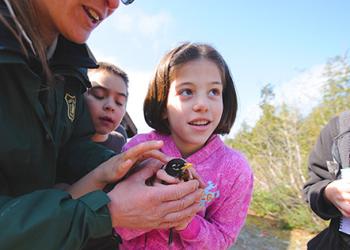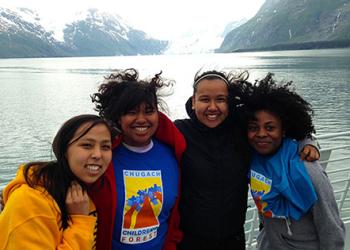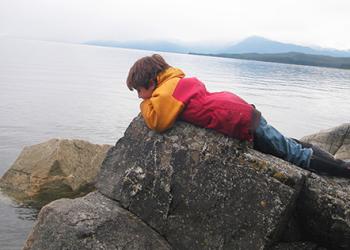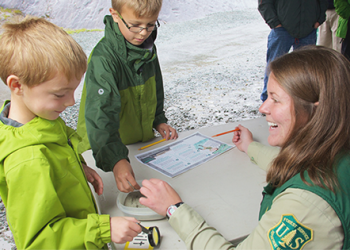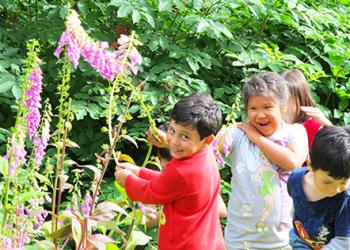Educators
The future needs adults who have an understanding of the natural world and know how to make wise environmental decisions. In order to become those adults, the kids of today have to spend time outdoors playing and learning. Parents, teachers and youth leaders fill a vital role in providing enjoyable and educational outdoor opportunities for children and youth.
Discover the Forest
Parent and Teacher Educational Resources
- Project Wild – Project WILD links students and wildlife worldwide through curriculum, resource materials, educator workshops, and other means.
- "Growing Up Wild - Exploring Nature with Young Children" – is a wonderful book of activities for 3-7 year old children, developed by the Council for Environmental Education in cooperation with Project Wild. The book is available from this website or to people who participate in a "Growing Up Wild" workshop. In Alaska those workshops are offered by the Department of Fish and Game.
- Project Learning Tree – Project Learning Tree (PLT) is the American Forest Foundation's environmental education program that provides teacher training and produces curriculum materials for students in grades PreK-12.
- Project WET – Project WET is a program to educate people world-wide about water resources and water management through teacher training and community events.
- Karst and Paleontology of the Tongass National Forest – education document was written by a group of scientists within and outside the Forest Service, and published by the Forest Service. It is designed for use by middle and secondary school teachers.
- Drinking Water and Ground Water Kids Stuff – This US Environmental Protection Agency site gives water-related lesson plans, games and activities (K-12) with an emphasis on water quality.
- The Climate Change, Wildlife and Wildlands Toolkit for Formal and Informal Educators – Developed in 2001 by seven federal agencies, this kit is now available on the Web.
- Ecosystem Matters – An extensive set of activities related to ecosystems and designed to supplement environmental studies.
- Weed Wackers! K-6 Educators Guide to Invasive Plants of Alaska (13mb pdf) – is an independent publication produced in cooperation with the Alaska Committee for Noxious and Invasive Plant Management, Fairbanks, Alaska.
Every Kid Outdoors provides the opportunity for fourth graders and their families to have access to public lands for free with the Every Kid Outdoors pass (America the Beautiful Equivalent)!
You can learn more here everykidoutdoors.gov. Some stipulations apply, so make sure to read about possible restrictions.
Who is involved:
Families can have access to all federal lands and waters from the following agencies:
- U.S. Bureau of Land Management
- U.S. Bureau of Reclamation
- National Oceanic and Atmospheric Administration
- National Park Service
- U.S. Fish and wildlife
- U.S. Forest Service
- U.S. Army Corps of Engineers
How to get a pass:
Parents and teachers can access an application for the pass here everykidoutdoors.gov/pass.htm. All adults should read the “parents” section to learn more about the regulations involved. If parents would like their fourth grader to receive a pass, they should work through the Adventure Diary with them in the “fourth graders” section. Teachers (including home-school teachers) can be directed to acquire the passes for their fourth-grade classes through the “educators” section.
How to plan a trip:
Go to the Chugach National Forest or the Tongass National Forest webpages to see what opportunities you and your family can do
If you are looking for other adventures to take in Alaska, click on the plan your trip page and take a look at the “where you can go” section to get an idea of different places you can go. Each public lands location will be managed by one a federal agency that will have specific information about the area and planning a trip for each site.
If you want to stay closer to home, check out which public lands are near you on the USA Federal Lands (be sure to zoom in close to catch the smaller sites).
USFS Involvement:
The pass currently includes access to 153 national forests, 20 grasslands and one tall grass prairie managed for the public by the Forest Service and other lands and waters managed by six other federal agencies. Some state parks also honor the pass.
#everykidoutdoors
Alaska’s National Forests offer tremendous opportunities to learn through observation, exploration and recreation. From the massive tidewater glaciers of Prince William Sound, the muskegs of Southeast Alaska, the caves of Prince of Wales Island; the Chugach and Tongass National Forests provide wonderful laboratories for outdoor studies. Enrich your outdoor learning experiences by looking through our website for helpful resources.
- 49 Sites in the 49th State - Join us on a virtual tour of 49 locations in our state.
- For Children & Youth - Opportunities and materials for young people up to about the age of 20
- History & Culture - Resources to help you learn about the history and pre-history of the Chugach and Tongass National Forests, and about the cultures of Alaska’s Native people
- Nature & Science - Information and teaching materials dealing with the natural resources of the forests
- Outdoor Safety & Ethics - Helpful tips for planning an outdoor experience in Alaska
- Visitor Centers - Information about major Forest Service visitor centers in Alaska
Be a Steward of the Past
- Cultural resources are non-renewable. Moving objects around and taking artifacts forever alters that site’s story.
- Respect local cultures by leaving things as you find them when visiting historical and archaeological sites.
- Cultural resources on public lands, including their structures and artifacts, are protected by law.
- Take only photographs, leaving features undisturbed and artifacts where you find them.
- Being a steward of the past means protecting our land’s cultural resources for future generations to cherish and experience.
- The heritage of public lands belongs to everyone. It’s all of our responsibility to preserve and protect it.
- Help preserve the past! Volunteer and become a site steward.
- If you share a photo or site location on social media or with a friend, share these stewardship messages.
What is Culture?
Culture is comprised of those beliefs, social structures, customs, traditions, and material traits specific to a group of people that make each group unique.
Many groups of people contribute to the rich cultural tapestry of Alaska. Because of their close relationship with the forests since time immemorial, Alaska Natives have special significance in any study of the Tongass and Chugach National Forests.
The history, or chronological record of events that have occurred on the lands that are now the Tongass and Chugach, is also important in a study of the Forests.
Learn some words of the many languages of Alaska. Languages referenced include Lingít (also known as Tlingit), Xaad Kíl (also known as Haida), Sm’algyax (also known as Tsimshian), Eyak and Alutiiq.
Learn More!
Visit the State of Alaska Office of History and Archaeology website to access a variety of documents related to these topics.
- Fort Babcock is eligible for inclusion on the National Register of Historic Places for its association with World War II
- Check out the upcoming Comprehensive Environmental Response, Compensation, and Liability Act (CERCLA) clean-up effort at Fort Babcock – led by the U.S. Army Corps of Engineers. Click here for more information.
- Heritage Sites on the Chugach and Tongass National Forests
- Alaska Native Cultures
- Alaska Region Programmatic Agreement
- Historic Cabins and Shelters Programmatic Agreement
- Tongass National Forest Heritage Program
- A brief timeline of Alaska statehood and Alaska's National Forests




